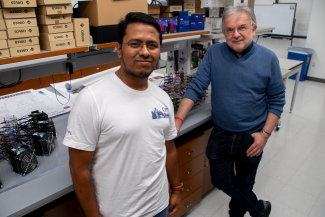
What once demanded powerful computers and research lab resources can now happen in real time at a patient’s bedside. Thanks to groundbreaking AI research at The University of Texas at Austin, 3D medical imaging is becoming faster, smarter, and cheaper, making it accessible to hospitals and clinics everywhere and ushering in a new era of affordable, high-performance diagnostics.
A research team led by Professor Radu Marculescu and PhD student Md Mostafijur Rahman in the Chandra Family Department of Electrical and Computer Engineering have made great strides in the medical imaging community with a string of influential papers that dramatically improve the efficiency and accuracy of AI-powered image segmentation.
With broad applications in areas such as tumor detection, organ segmentation, and surgical planning, these innovations mark an important step toward AI systems that are not only state-of-the-art, but also accessible for hospitals and clinics worldwide.
“Medical imaging models often require huge memory and computing power. By rethinking design and architecture, we’re showing it’s possible to dramatically cut costs while preserving — or even improving — performance,” said Rahman, the lead author on the work.
EffiDec3D, a new AI tool for analyzing 3D medical images, was designed to run faster and use fewer resources—without losing accuracy. This breakthrough improved how efficiently large 3D medical imaging models can perform. The work was presented at CVPR 2025, the world’s leading computer vision conference.
By combining multi-scale receptive fields in a lean, two-phase–optimized smart design, EfficientMedNeXt achieved record-setting results in 3D medical image analysis. It was recently presented at MICCAI 2025, the premier conference in medical imaging.
Together, the work reduces computing needs by 95% without sacrificing accuracy. It forgoes the need for expensive GPUs and complex cloud setups and allows for real-time diagnostics right at the patients’ bedsides.
“Our work is about doing more with less — designing AI that is not only accurate, but also lean, fast, and resource-aware,” said Professor Marculescu. “That’s essential for clinical adoption, where efficiency directly translates into faster diagnoses and broader access to care.”
Looking Ahead
In collaboration with Dell Medical School, the team plans to move from single-site lab demos to pragmatic, multi-hospital evaluations focused on reliable and seamless integration in the clinical workflow. The next goal is a privacy-preserving, interoperable platform that can turn 3D imaging into faster and more equitable care everywhere.
The Team
Radu Marculescu is a Professor and the Laura Jennings Turner Chair in Engineering in the Department of Electrical and Computer Engineering at The University of Texas at Austin. Radu is a Fellow of IEEE and a Fellow of ACM. He leads the System Level Design Group in Texas ECE.
Md Mostafijur Rahman is a PhD student in the Chandra Family Department of Electrical and Computer Engineering. Prior to joining UT Austin, he studied at the University of Dhaka.
